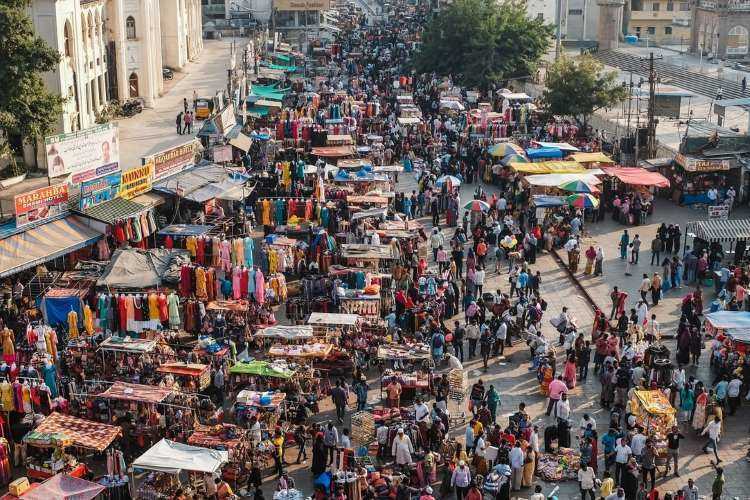
India has overtaken China as the most populous country — with the confirmation coming from the United Nations Population Fund. The country which covers nearly 2.4% of world’s land mass is now home to 1.4 billion people, or 20% of humanity. The country has more people than the Americas, Africa, and Europe. The best part of all this is that while China is also endowed with great human resources, its population is aging and shrinking. India’s population is relatively young and growing. This demographic shift poses major economic and social challenges, but at the same time offers a world of opportunities for the country.
According to the UN Population Fund’s World Population Dashboard which was released on Wednesday, 68% of the country’s population is between ages 15 and 64 years which is considered working age. About 25% is below 14 years; 18% between 10 and 19 years, and 7% above 65 years. It is expected that the rise in Indian population will continue to peak in the early to mid-2060s, after which it will plateau.
READ | Russia-India FTA can boost time-tested trade ties
China’s population fell in 2022 with more deaths than births. This is the culmination of a long-term decline of the country’s birth rate. Population experts blame the one-child policy followed since 1980 for the decline. If the average number of children in a country’s families falls below 2.1, or the replacement rate, the population will shrink. The Chinese authorities have scrapped the one-Child policy.
Challenges in front of India
This large population comes with its own set of opportunities and challenges. Andrea Wojnar, the representative for United Nations Population Fund (UNFPA) in India calls India’s 1.4 billion people as 1.4 billion opportunities. The country’s 254 million youth (15-24 years) can be a source of innovation, new thinking and lasting solutions. India has the largest population of young people in the world.
Leveraging this demographic dividend is key to India becoming a global economic powerhouse. India can both produce and consume more goods and services, drive innovation and keep pace with the constant technological changes. There is an ongoing transition with the economy becoming industrialised, but the country must be prepared for it and deliver the vast number of jobs that the transition will demand.
India also enjoys demographic diversity within states which also offers unique opportunities. One state’s challenges can be another state’s opportunity. For example, states in southern India have an ageing population and these states can meet their labour demand from other states.
The Union and state governments need to bring in policies to leverage India’s demographic dividend as this unique window of opportunity will close soon. Special attention needs to be paid on equipping girls and women with equal educational and skill-building opportunities, access to technology and digital innovations, and most importantly with information and power to fully exercise their reproductive rights and choices, the UNFPA representative says.
A public survey was commissioned by UNFPA as part of the report and it was conducted by YouGov. The survey indicates that population anxieties are widespread and governments across the world are increasingly adopting policies aimed at raising, lowering or maintaining fertility rates. The greatest population related concerns are dwindling natural resources, economic issues, environmental concerns and sexual and reproductive health and rights, as well as human rights.
The biggest challenge of all is climate change which has resulted in heat waves across the country, causing deaths and widespread suffering. Rising global temperatures also threaten food security in the country which is largely agrarian. The country is also facing acute water problems including shortages and pollution. About 40% of rural households don’t have running water supply.
Then there are unemployment concerns. Close to a third of the nation’s youth are not in employment, education or training. Only 5% of the country’s workforce is recognised as formally skilled.
The respondents of the survey held that India’s population was too large and fertility rates too high. The general population does not see it as a boon. However, India is in a unique position in which the young and working population is larger than the population which needs care — i.e children and the elderly. Several countries have a shrinking youth population while the share of the elderly people is on rise. This includes China and Japan. These countries are in need of skilled labour, and this is something that India can provide, while capitalising on the demographic dividend.
While it may seem that the whole world is witnessing a boom in population, it is far from true. Over the last 50 years, fertility rates have dropped drastically around the world. In 1952, the average global family had five children, now, it is less than three. Lower fertility rates, coupled with increased life expectancies around the world, are creating an aging population. According to a report by the World Bank, the world’s working-age population peaked back in 2012. Since then, it’s been on the decline.
India’s own method of calculating population had hit a roadblock during the COVID-19 pandemic. The census was supposed to be conducted in 2021 when the world was in the middle of the pandemic crisis, but the same was deferred by the government citing pandemic disruptions.

